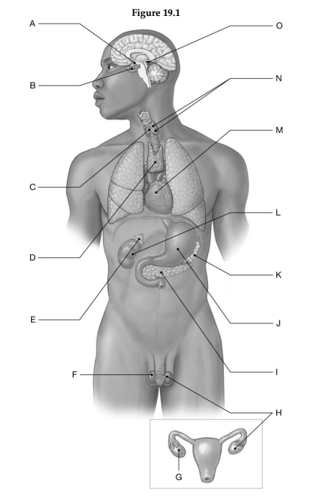Using the figure above, identify the labeled part.

1. Label A: ______________________________
2. Label B: ______________________________
3. Label C: ______________________________
4. Label D: ______________________________
5. Label E: ______________________________
6. Label F: ______________________________
7. Label G: ______________________________
8. Label H: ______________________________
9. Label I: ______________________________
10. Label J: ______________________________
11. Label K: ______________________________
12. Label L: ______________________________
13. Label M: ______________________________
14. Label N: ______________________________
15. Label O: ______________________________
1. Hypothalamus
2. Pituitary gland
3. Thyroid gland
4. Thymus
5. Suprarenal glands
6. Testis
7. Ovary
8. Gonads
9. Pancreatic islets
10. Digestive tract
11. Adipose tissue
12. Kidney
13. Heart
14. Parathyroid glands
15. Pineal gland
You might also like to view...
Which of the following is true of the sodium-potassium exchange pump?
A) It maintains sodium at equal intracellular and extracellular levels. B) It is a passive transport process. C) It moves sodium into the cell and potassium out of the cell. D) There is one type of carrier protein for sodium and a different type of carrier protein for potassium. E) It is an example of active transport.
The small intestine requires vitamin D to adequately absorb calcium
Indicate whether the statement is true or false
A vasodilator causes a decrease in local blood flow at a capillary bed.
Answer the following statement true (T) or false (F)
Why are some salts excreted?
A. They maintain proper salt concentration in the blood. B. They are not excreted. C. They are end products of metabolism.